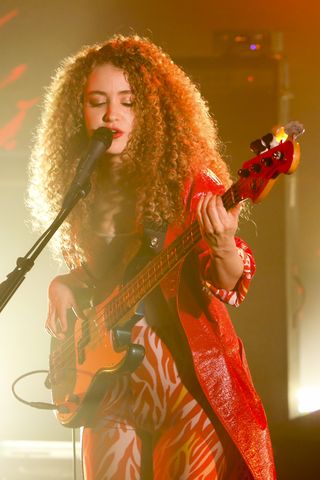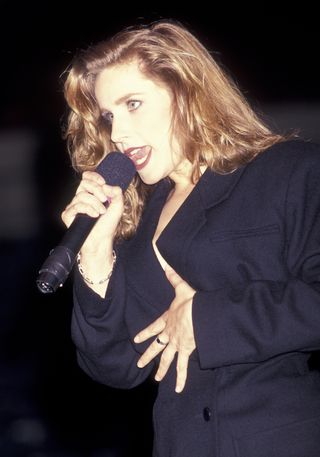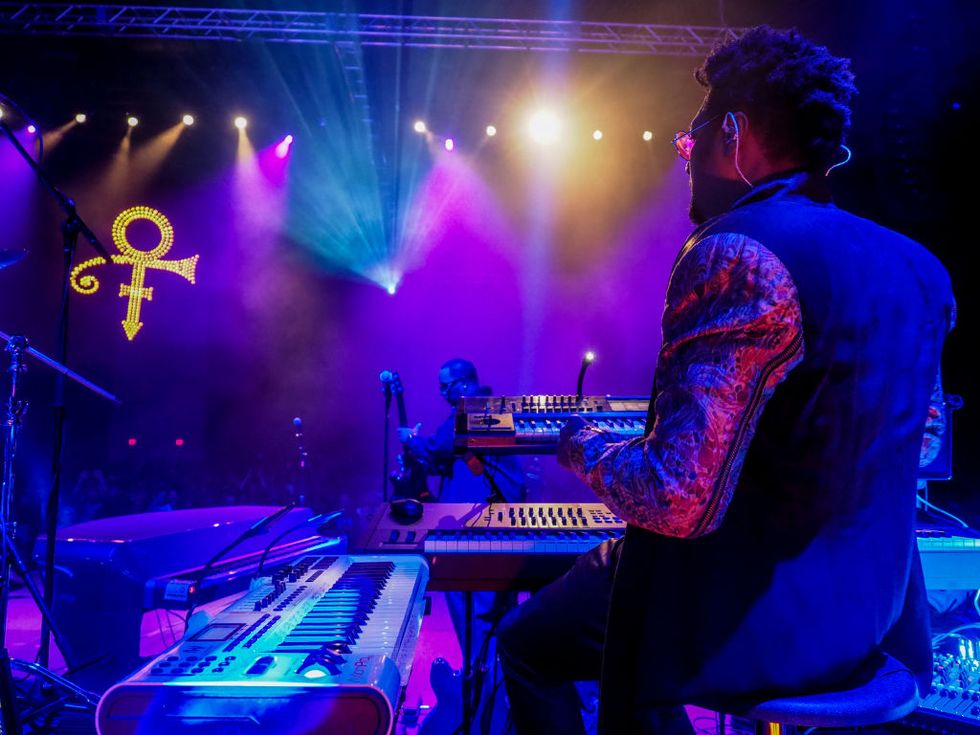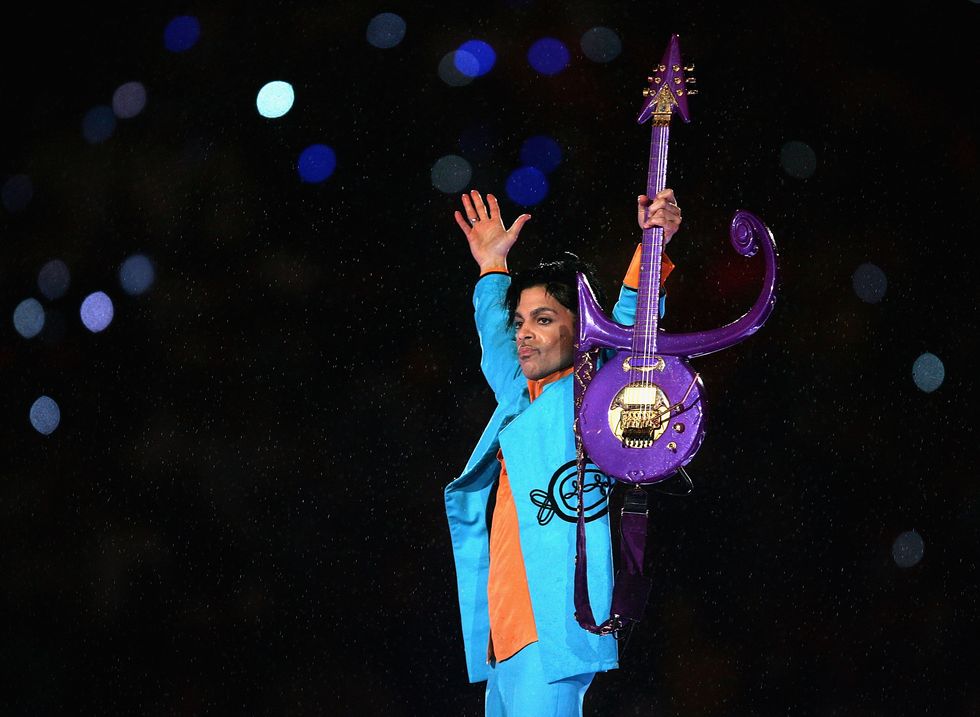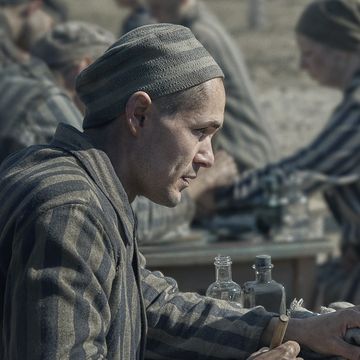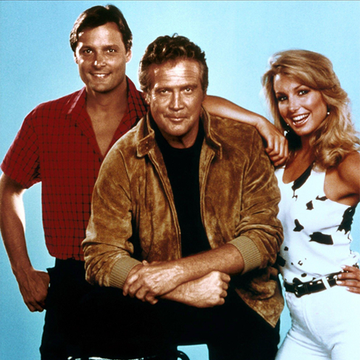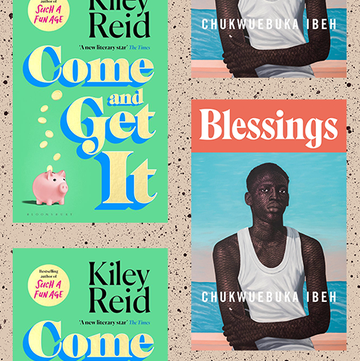In 2008, Tal Wilkenfeld’s phone rang. The 21-year-old, Australian-born bass player was surprised to hear Prince on the other end of the line, and even more taken aback when his first words to her were, “Do you like the drum rolls of Jack DeJohnette?” Since her own playing was rooted in jazz—she had toured with Chick Corea and played with Herbie Hancock, in addition to backing Jeff Beck—she was certainly familiar with the former Miles Davis sideman. “‘He’s one of my favorite drummers,’” Wilkenfeld recalls replying.
That conversation set in motion one of Prince’s most mysterious projects, an album with an entirely new band that was completed and lent its name to a celebrated tour, but was never actually released—until now. On July 30, the Prince Estate is putting out Welcome 2 America, a 12-track standalone record from 2010. The set marks the first time since Prince’s 2016 death that material from his legendary vault is officially coming out that isn’t alternate tracks or outtakes from existing albums or live recordings, but an actual “brand-new” Prince album.
Stripped down and tightly focused, Welcome 2 America doesn’t sound like anything else in Prince’s catalog, and displays a strong social commentary that’s bracingly relevant more than ten years after its recording. “It’s a very stinging rebuke to some of the things that were happening in America,” says keyboardist and co-producer Morris Hayes, “People say ‘Oh, he wasn’t political,’ but this proves that he was very socially conscious, very much aware of what was going on around him.”
When Prince placed that call to Wilkenfeld, he was at an odd moment in his career. The previous year, he had delivered his monumental Super Bowl performance, still widely considered the finest halftime show in NFL history. But the rock-oriented Planet Earth album, released in July 2007, met with middling reviews and minimal commercial impact, failing to even go gold. In the UK, he gave the album away with copies of the Mail on Sunday newspaper.
Prince brought Wilkenfeld to parties at his Los Angeles home (sometimes he and his band played and she was their lone audience member), or they drove around together in a limo listening to music. He called her once to work on something he was doing with Beyoncé, but the bassist was in the middle of a session. Then, finally, in 2009, they spent a few days jamming intensely in a Burbank studio.
Months later, he called her from Minneapolis and said that he wanted to put together a trio with her, asking her to find them a drummer. They settled on Chris Coleman, who had been playing with such R&B singers as Chaka Khan and Rachelle Farrell, and Prince flew the two musicians to Paisley Park for the first time in late 2009.
The serious recording came a few trips later, in March and April of 2010. “We didn’t rehearse, not even in the studio before we recorded,” says Wilkenfeld. “We were rolling to tape; he’d count it off, and we’d do one or two takes, and you better get it right.”
Prince told her that he was feeling inspired by the Jimi Hendrix Experience. “Even though it later evolved into having keyboards and background vocals,” says Wilkenfeld, “the album was essentially recorded as a trio, so it has that raw vibe.”
On these sessions, though, Prince wasn’t singing any lyrics. While it was both liberating and challenging for the rhythm section to not have any vocals to play off of, Wilkenfeld recalls, she and Coleman also had no idea what the final songs might turn into.
In the early ‘90s, a former teenage Star Search winner named Elisa Fiorillo contributed vocals to a few Prince records. They hadn’t been in touch for more than twenty years when he saw a YouTube video of Fiorillo singing with a jazz trio, and he contacted her to see if she might come to LA and sing—first, with a new young singer, but ultimately as part of his band, alongside vocalists Liv Warfield and Shelby J.
The three women came to Paisley Park to record on the new tracks cut with Wilkenfeld and Coleman. “We would all sit on a couch in Studio A and he would give us the lyrics, teach us the harmony parts, and we just went in and cut it,” says Fiorillo. “Many times the harmonies were just crazy and I’d think, ‘How is this gonna work?’ And then you’d listen to the end product and just be mesmerised at how his melodies intertwined and the harmonies fit incredibly.”
He featured their voices on a cover of Soul Asylum’s “Stand Up And B Strong” (not that Fiorillo knew it was a song by the Minneapolis alt-rockers; “I thought it was just by some random guy”). Mostly, Fiorillo recalls Prince’s mood, which she says was much happier than he had been in the ‘90s. They would go out to clubs or just drive around blasting the new songs—cruising around the arboretum bopping their heads to “Same Page, Different Book,” rolling the windows down in downtown Minneapolis to road-test “Hot Summer,” “I thought for sure we were going to get attacked,” she says.
She brought her daughter to dinner at the studio—where they ate vegan meals while Finding Nemo played on a movie screen with the sound off—and he insisted that she visit regularly: “He’d say ‘Where’s your daughter? Don’t come next time if you don’t bring her!’ “
“He was very kid-like,” says Fiorillo. “He never held grudges because he was too busy creating stuff and thinking of what was next to let any of that stuff hold him back. I tried to talk to him once about my relationship with my mother and he said, ‘I don’t talk about problems.’ He was very much in the now and in the future, never in the past.”
Once the tracks were done, he called Hayes, who had been a member of Prince’s band, the NPG, since 1992. “When I pulled up in the parking lot,” says Hayes, “he was already sitting there in his car and said ‘Hop in.’ I got in and he said—you know how he does—‘I got some hot stuff!’ “
As they listened, Prince asked Hayes if he would produce the album. “He said, ‘Do your thing and anything I don’t need, I’ll just take it away.’ At the same time, what I really dug about it was that everything was extraordinarily raw, so I knew I didn’t want to do too much.”
He gave Hayes a CD of the new songs—not even files or separate tracks—so the keyboardist had to strip out and rebuild the different parts in his home studio. Hayes worked on one track each day, moving on to the next after Prince signed off. “I was just fingers crossed, every day,” he says. “Each day it was ‘Great,’ and some days, he said it was really great, shook me on the shoulders. I never had that kind of accolades from him before.”
What also became clear was that Prince was speaking out about social issues in a new way. “It was definitely thematic,” says Hayes, “more of an album album than a bunch of singles.” Songs like the Curtis Mayfield-inflected “Born 2 Die” addressed the tensions and inequalities of a moment when the heady optimism of the early Obama years met the realities of the economic crash. “Welcome 2 America” set the tone, taking on celebrity culture, social media, and racist hypocrisy. “Hope and change/Everything takes 4ever/The truth is a new minority,” Prince sang.
“He was really speaking to some of the things that he saw coming around and changing society—the iPhones and iPads and these types of technology,” says Hayes. “He kinda shunned those things. He never had a cell phone, he always used somebody else’s. So how these things were taking over concerned him.”
“I love that he wrote about the iPad just a month or two after the first iPad came out,” says Wilkenfeld. “It was hilarious to me how quickly he jumped on things like that.”
“1000 Light Years from Here” offered an underwater utopian alternative, while “When She Comes” was Prince Classic in its slow-burn melody and racy lyrics. “I told him ‘Dude, this is gonna get you kicked out of the Witness Protection program’—which I called the Jehovah’s Witnesses,“ says Hayes. “We had a chuckle about that.”
“He wouldn’t let us sing on that one because it was too risqué for us,” says Fiorillo. “He played just a small bit and was like ‘OK, that’s enough,’ and turned it off.”
The Welcome 2 America album was seemingly finished, and a world tour with the same title was announced, including 21 nights at the LA Forum. And then—nothing. The shows were joyous, celebratory, but the project was shelved, with no sign of these songs or recordings surfacing. Instead, in July, he released the lackluster 20Ten album, described as a “personal diary of the year” on which he returned to playing all the instruments himself.
No explanation was offered to the musicians, but one possibility is that he lost interest after it became clear that Wilkenfeld wouldn’t be able to join him on the road. “He asked if I was available to tour,” she says, “but unfortunately I was already booked that whole year, with Jeff Beck and then with Herbie Hancock. I’m grateful that I wasn’t disloyal to anybody—I stuck to my word on the commitments I’d made—but I’m always going to be bummed that we didn’t get to tour, or to explore this music more.”
So Welcome 2 America sat in the vault, until last year, when official archivist Michael Howe found three CD-Rs with a tracklist in Prince’s handwriting. The themes of “Running Game (Son of a Slave Master)” and “One Day We Will All B Free” seemed more important than ever, especially coming from a man born and based in the city where George Floyd was murdered, and the decision was made to move forward with a major addition to this incomparable body of work.
“I feel like he was such a forward thinker, he wrote it then and he knew it would apply later,” says Fiorillo. “It’s ironic that he’s gone but his music and his lyrics live on, and are just perfect for what’s going on in the world. In a weird way, he’s speaking to all of us from beyond—from ‘1000 Light Years From Here’—and every time I hear it, I feel like he’s still here.”
“It just goes to show how incredibly insightful he was,” says Hayes. “This man was a sage—like with Sign o’ the Times, looking to the future and see how things are going to be. Listen to some of these lyrics and look where things are socially, technologically, and it’s just incredible.
“That’s the beautiful thing about music. It doesn’t have an expiration date.”
Author and music journalist Alan Light is the former Editor-in-Chief of Vibe and Spin magazines. His books include The Holy or the Broken: Leonard Cohen, Jeff Buckley, and the Unlikely Ascent of "Hallelujah."


